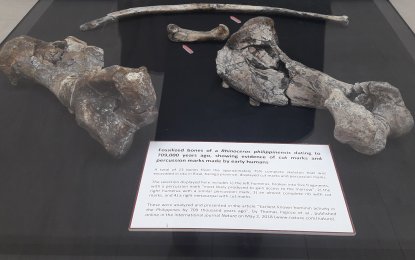Art and Culture
Nat’l Museum shows oldest proof of hominin existence in PH

Four of the 13 Rhinoceros Philippinensis bones, with cut and butcher marks, were analyzed and presented in the article “Earliest known hominin activity in the Philippines by 709,000 years ago” by Dr. Thomas Ingicco, et al. The fossils are now on display at the National Museum of Natural History. (Photo by Ma. Teresa Montemayor/PNA)
MANILA — The National Museum has announced the publication of the article titled “Earliest known hominin activity in the Philippines by 709,000 years ago” in the May 10, 2018 issue of the journal Nature.
In a press briefing on Thursday, National Museum of the Philippines (NMP) Director Jeremy Robert Barns discussed the details of the article which presented the oldest evidence for the occupation of hominins — species generally of the genus Homo including Homo Sapiens or modern humans — in the Philippines.
Barns said the article “relates the discovery of an almost complete skeleton of Rhinoceros Philippinensis with cut and percussion marks, stone tools and a tektite which are archaeological findings considered as indirect evidence for a very old presence of early humans on the island of Luzon far beyond the former earliest published evidence of 67,000 years relating to a hominid bone fragment from Callao Cave, Cagayan.”
The fossils were discovered in an archaeological site in Rizal, Kalinga province by a team of international and local researchers led by Dr. Thomas Ingicco from the Museum National d’Histoire Naturelle.
Archaeological finds’ implications
Barns said “discovering the remains of the rhinoceros and the stone tools within the same layer points to association or coexistence of the two in the past.”
To identify the age of the finds, at least five dating methods were used, he said.
“One of them hit the nail on its head, the Australasian tektite which formed during a major meteoritic impact just before the onset of the Brunhes Normal polarity epoch at 781,000 years ago and the other four just supported it,” Barns said.
He added that the finds imply that “hominins were present in the Philippine Islands as early as 709,000 years ago.”
“This is part of our heritage, the fact that this discovery is part of our country and related to advancing scientific knowledge which is why there is so much international interest on the paper, article also and it’s something to make every Filipino proud,” Barns added.
UP-Archaeological Studies Program representative Kathryn Manalo said that their team was not expecting to find anything valuable since the research project started in 2014.
“When we found the tooth of the rhinoceros, we thought it was just a typical pebble-like as what the locals said. But we waited for it to be exposed enough and be measured, and we were amazed because it was the first part of the rhino that we found,” Manalo said.
She said they were amazed when they found and analyzed all the bones which had been butchered or modified by early humans.
“It’s not every day that archaeologists find something of that importance. It was a surreal moment. At that time, we haven’t really realized the impact of what we found,” she added. “The very fact that we were able to push back our history to 700,000 years ago, this will bolster our nationalism, this will strengthen our identity as Filipinos.”
For his part, NMP Acting Assistant Director Angel Bautista said: “When we find something significant like this, it satisfies us…sometimes we even cry.”
Ateneo de Manila University Sociology and Anthropology instructor Mylene Lising said that discoveries like this help Filipinos understand their origin more.
“We have a better understanding of the land on which our country sits on now…This is scientifically proven, we went through rigorous review of the paper…it’s science. We have all the evidence and it’s not fake news, this good news and this is real,” Lising said.
NMP Senior Museum Researcher Catherine King said, “The hominin tool makers said to have existed in Kalinga are not related to us nevertheless we share the same heritage with the rest of the world.”
Meanwhile, Kalinga Mayor Marcelo dela Cruz is grateful for the honor that the research project and its findings have given to their community.
“Makikilala pala sa mapa ang Rizal, Kalinga, salamat sa team… The National Museum or the team help us magkaroon ng trabaho at tumutulong sila ma-protektahan ang area (Thank you to the team because Rizal, Kalinga would be known in the map…The National Museum or the team help us have jobs and protect the area), the economic activity will grow in our place because of these finds,” dela Cruz said.
The tooth and three of the fossilized bones of the Rhinoceros Philippinensis are on display at the National Museum of Natural History while the rest are kept in a safety vault.





















